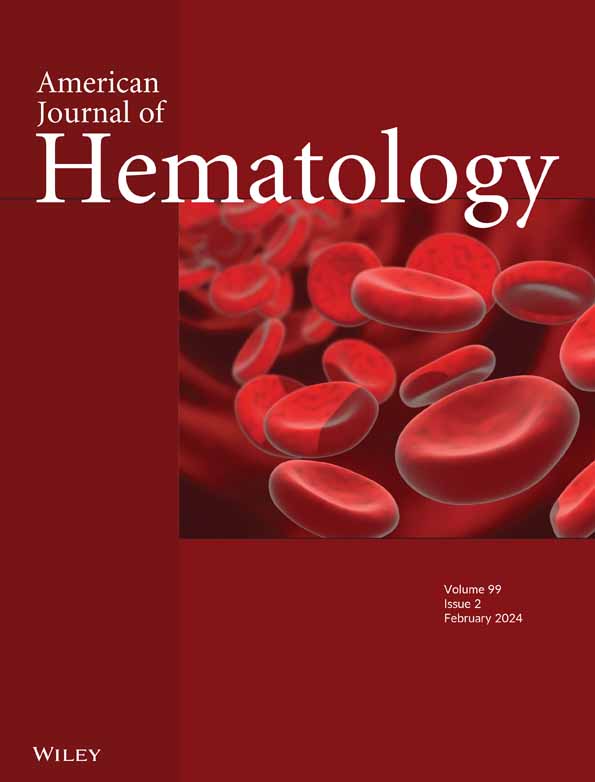唾液酰T抗原:恶性疟原虫入侵的一种新的红细胞决定因子
IF 9.9
1区 医学
Q1 HEMATOLOGY
引用次数: 0
摘要
尽管控制措施取得进展,但疟疾继续在全球构成重大的健康挑战。恶性疟原虫是导致大多数严重疟疾病例的寄生虫,它在感染的血液阶段使用多个冗余入侵途径进入红细胞(RBC)。通过在红细胞中进行RNA干扰筛选和在原代人造血干细胞中进行CRISPR/Cas9介导的敲除验证,我们发现糖基转移酶Core 1合成酶糖蛋白‐N‐乙酰半乳糖胺3‐β‐半乳糖转移酶1 (C1GALT1)是恶性疟原虫入侵的一个新的宿主决定因素。对缺乏C1GALT1的培养网状红细胞和无糖蛋白A/B的MkMk血型表型的红细胞的分析表明,黏素型O -聚糖中C1GALT1依赖的α(2 - 3)唾液酸结构对唾液酸依赖和唾液酸不依赖的恶性疟原虫菌株的有效入侵至关重要,但对灵长类疟疾寄生虫诺氏疟原虫则没有作用。然而,不同的恶性疟原虫菌株对红细胞表面不同的唾液酸构型表现出不同的依赖性。总之,我们的发现强调了红细胞聚糖在疟疾感染中的关键作用。本文章由计算机程序翻译,如有差异,请以英文原文为准。
Sialyl‐T Antigen: A Novel Red Blood Cell Determinant for Plasmodium falciparum Invasion
Malaria continues to pose significant health challenges globally despite advances in control measures. Plasmodium falciparum , the parasite responsible for most severe malaria cases, uses multiple redundant invasion pathways to enter the red blood cell (RBC) during the blood stage of infection. Through a combination of RNA interference screening in erythroid cells and validation by CRISPR/Cas9‐mediated knockout in primary human hematopoietic stem cells, we identified the glycosyltransferase Core 1 Synthase Glycoprotein‐N‐Acetylgalactosamine 3‐Beta‐Galactosyltransferase 1 (C1GALT1) as a novel host determinant for P. falciparum invasion. Analyses of C1GALT1‐deficient cultured reticulocytes and RBCs with the glycophorin A/B‐null Mk Mk blood group phenotype demonstrated that the C1GALT1‐dependent α(2‐3) sialic acid structures within mucin‐type O‐glycans are crucial for efficient invasion of both sialic acid‐dependent and sialic acid‐independent P. falciparum strains, but not the primate malaria parasite Plasmodium knowlesi . However, different P. falciparum parasite strains exhibit variable dependencies on distinct sialic acid configurations on the RBC surface. Overall, our findings highlight a key role for RBC glycans in malaria infection.
求助全文
通过发布文献求助,成功后即可免费获取论文全文。
去求助
来源期刊
CiteScore
15.70
自引率
3.90%
发文量
363
审稿时长
3-6 weeks
期刊介绍:
The American Journal of Hematology offers extensive coverage of experimental and clinical aspects of blood diseases in humans and animal models. The journal publishes original contributions in both non-malignant and malignant hematological diseases, encompassing clinical and basic studies in areas such as hemostasis, thrombosis, immunology, blood banking, and stem cell biology. Clinical translational reports highlighting innovative therapeutic approaches for the diagnosis and treatment of hematological diseases are actively encouraged.The American Journal of Hematology features regular original laboratory and clinical research articles, brief research reports, critical reviews, images in hematology, as well as letters and correspondence.

 求助内容:
求助内容: 应助结果提醒方式:
应助结果提醒方式:


